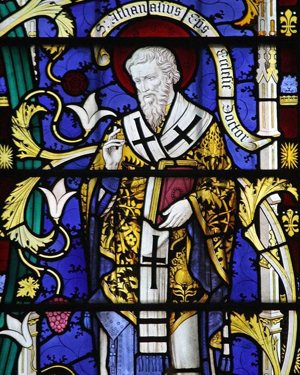St. Athanasius was born in Alexandria, Egypt, in 295. He had a strong Christian upbringing, was educated in theology and Scripture, was ordained a deacon in 318, and became secretary to Bishop Alexander, the bishop of Alexandria.
St. Athanasius accompanied Bishop Alexander to the Council of Nicea in 325. There was a fierce battle between the orthodox bishops who upheld the teaching that Jesus has two natures, divine and human, and that he is true God and true man, and the Arians who insisted that Jesus is less than God, not divine, and the greatest of all human beings. The Council promulgated the Nicene Creed, condemned Arianism as a heresy, and excommunicated Arius.

Bishop Alexander died in 328 and St. Athanasius was elected his successor at the age of 33, the spiritual leader of the city of Alexandria, Egypt, Ethiopia, and the monks in the desert. Even though Arianism had been rejected by the Council, many still espoused the heresy, opposed St. Athanasius, and did everything possible to discredit him and undermine his authority.
Over the forty-five years that he served as bishop, his opponents had him exiled five times. On the first occasion his Arian adversaries falsely accused him of personal misconduct, multiple crimes, and collusion in the death of Arsenius, a prominent Arian bishop, who was alive and in hiding. The emperor Constantine summoned him to the Council of Tyre in 335. The bishops, most who were Arians, condemned him, and the emperor who had acquitted him initially reversed himself and had him exiled to Trier, Germany, in 336.
After Constantine died, his son, Constantius II, allowed St. Athanasius to return to Alexandria in 338. The same year a synod was called in Antioch, deposed him as bishop, and sent him into exile. An Arian bishop was installed in his place who later died in 346, and St. Athanasius was permitted to return a second time. He remained in Alexandria for ten years, but his opponents were relentless.
Two more councils were called, the first in Arles in 353, the second in Milan in 355, and the Arian majorities condemned St. Athanasius each time. Subsequently a band of soldiers attacked his church in 356, he escaped to the Libyan desert, and spent six years in hiding, protected by his priests and monks.
The Arian bishop of Alexandria was murdered, Constantius II died, and the new emperor Julian allowed St. Athanasius to return in 361. Julian ordered a return to pagan practices. St. Athanasius defied the order and was exiled by Julian from October 362 to June 363. Finally, the next emperor, Valens, sided with the Arians and sent Athanasius into exile a fifth time in 365. The emperor revoked his order four months later, Athanasius returned to Alexandria in 366, and spent his last seven years as bishop in Alexandria at peace.
St. Athanasius was a prolific writer, a true scholar, a clear teacher, and a powerful defender of the faith. He wrote many homilies and letters, and composed three major works: On the Incarnation, the Discourse Against the Arians which explained the Trinity and Jesus as Son of God, and the Life of Anton, a biography of St. Anthony of the Desert which also explained the beginnings of the monastic movement.
St. Athanasius is one of the four great doctors of the Eastern Church, along with St. Basil the Great, St. Gregory Nazianzen, and St. John Chrysostom. He is remembered as the “Champion of Nicea” and the “Doctor of the Incarnation.” He may not have been a martyr, but he suffered greatly for the faith. He died on May 2, 373.




